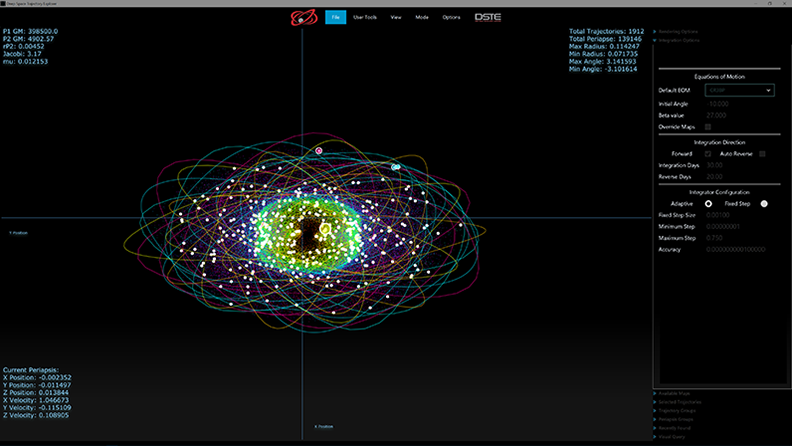
Automated
Contact:
Angelica DeLuccia
Griffin Communication Group
Ph: (321) 506-2183
angelica@griffincg.com
 Lanham, MD – a.i. solutions’ Deep Space Trajectory Explorer (DSTE) Quarter 2 software release contains new features and functionality in Integration and 3D Interface for Generating Libration Point Orbit Families.
Lanham, MD – a.i. solutions’ Deep Space Trajectory Explorer (DSTE) Quarter 2 software release contains new features and functionality in Integration and 3D Interface for Generating Libration Point Orbit Families.
Integration Upgrades
The DSTE Integration and 3D visual systems have been enhanced to track trajectory data in both the base rotating and inertial in parallel. This allows the user to instantly convert the 3D view for insight. This applies equally to libration families as generated by the libration generation GUI and trajectories selected using other tools such as maps and transfer generation tools.

The Integration system now can integrate with all equations of motion using an Adaptive Step RungeKutta78 Integrator. For most scenarios this provides an order of magnitude speed improvement without sacrificing quality. Users can switch between adaptive and fixed step using the Integration Options GUI.

3D Interface for Generating Libration Point Orbit Families
In previous DSTE releases libration point orbit families were computed using a text-based configuration file. To augment this capability, the DSTE allows a user to generate families directly from the DSTE GUI. Certain families will be available from drop-down menus for fast generation. The user may optionally specify system parameters onscreen with an initial guess for the first family member, allowing the generation of families not yet cataloged.

With a button click both the configuration file and optionally the libration family are generated, dynamically rendering on screen. This allows the user to quickly and painlessly visualize libration families that are defined within the internal data files.

Upcoming 2018 Beta Release Features
The following new DSTE features are in development currently and targeted for 2018 release:
- Visual Timeline
To assist the user with forming and exporting better trajectories and initial guesses intended for downstream tool chains, a new Visual Timeline GUI is in development. This interface allows the user to visually concatenate individual trajectory arcs using simple drag and drop controls. Reasonably close but discontinuous arcs can be stitched together using a multiple shooter-based optimizer whose parameters can are configurable by the user. - Low-Thrust Trajectory Modeling Tools
To augment mission design workflows requiring low-thrust propulsion, the DSTE will provide local optimizers for low-thrust modeling. A GUI interface will be provided that allows the user to configure the optimization process to align with their propulsion control laws. - DSTE-to-FreeFlyer® Integration Via the FreeFlyer Runtime API
This capability will focus on the export of trajectories generated in the DSTE using the CR3BP, BCR4BP, or AHR3BP equations of motion, and correction into a higher-fidelity force model in FreeFlyer. Candidate trajectories include NRHOs, other halo orbits, DROs, etc., as well as quasi-periodic orbits and transfers generated from Poincaré maps and the map stacker tool. This feature will allow the user to select a desired orbit in DSTE and correct and visualize the orbit in various reference frames in FreeFlyer. The direct integration with FreeFlyer will be optional. Users will not be required to install FreeFlyer or use this particular feature. - Interplanetary Transfers
Currently, the DSTE connects trajectory arcs within a single Sun-planet or planet-moon system through the map stacker. This capability will be augmented to connect trajectory arcs between multiple Sun-planet or planet-moon systems, allowing the user to generate end-to-end trajectories between the Earth and deep space destinations.


